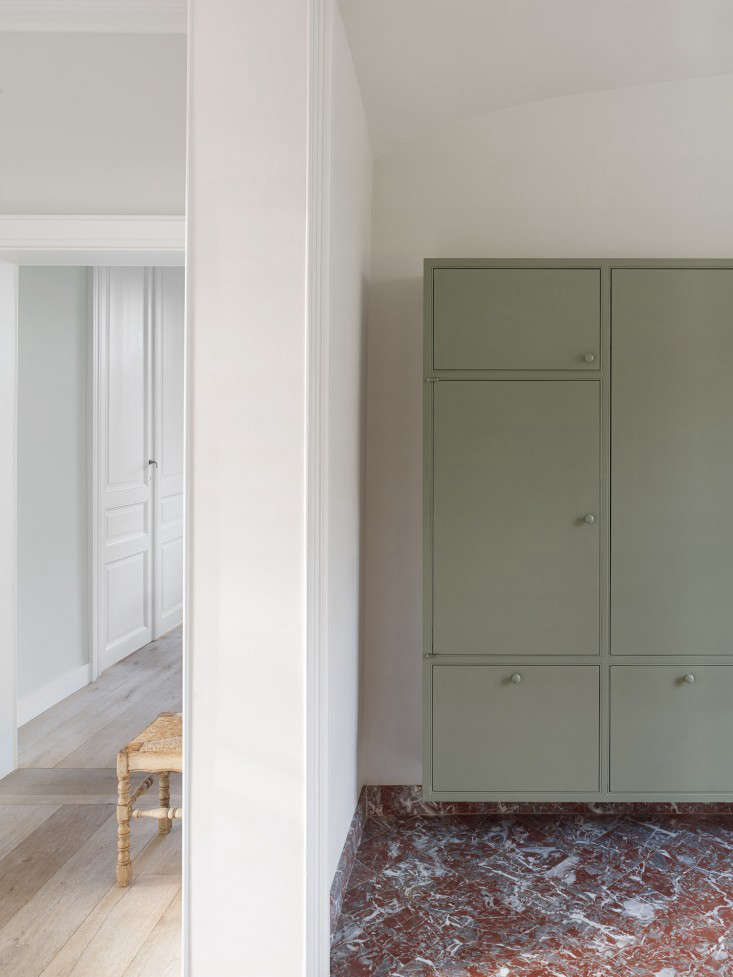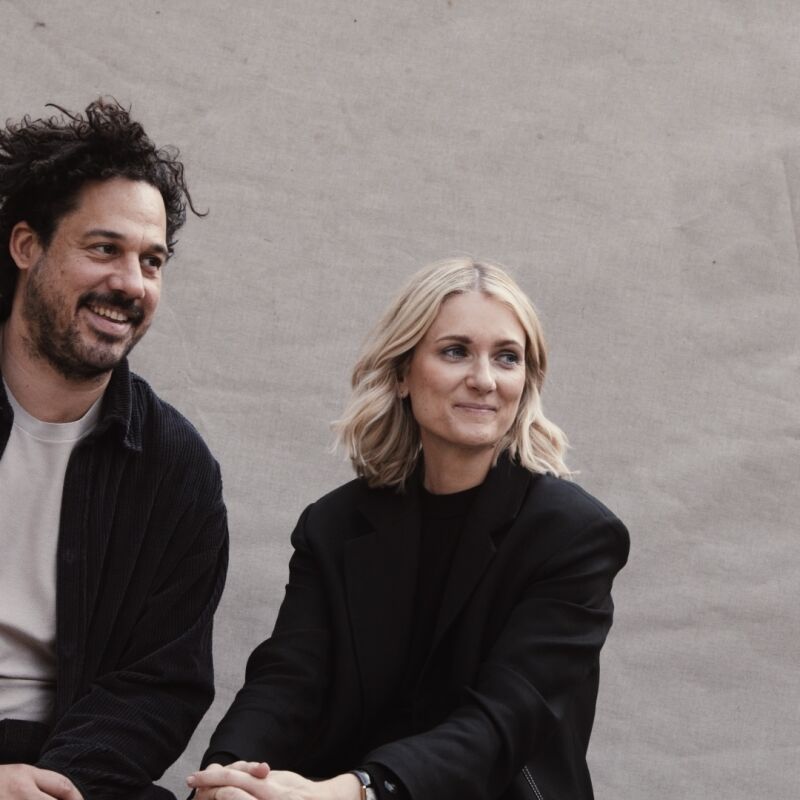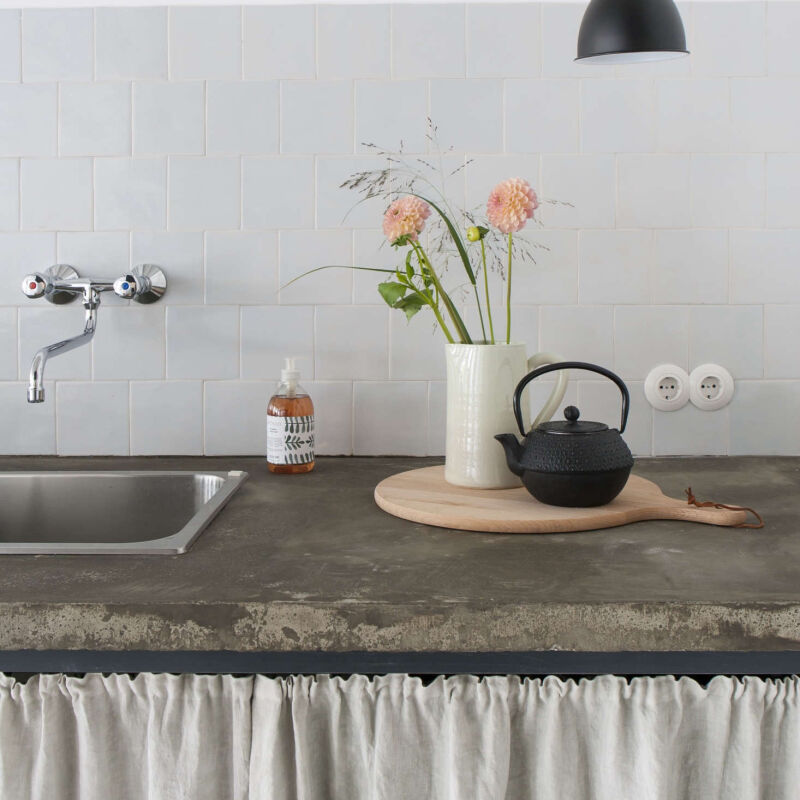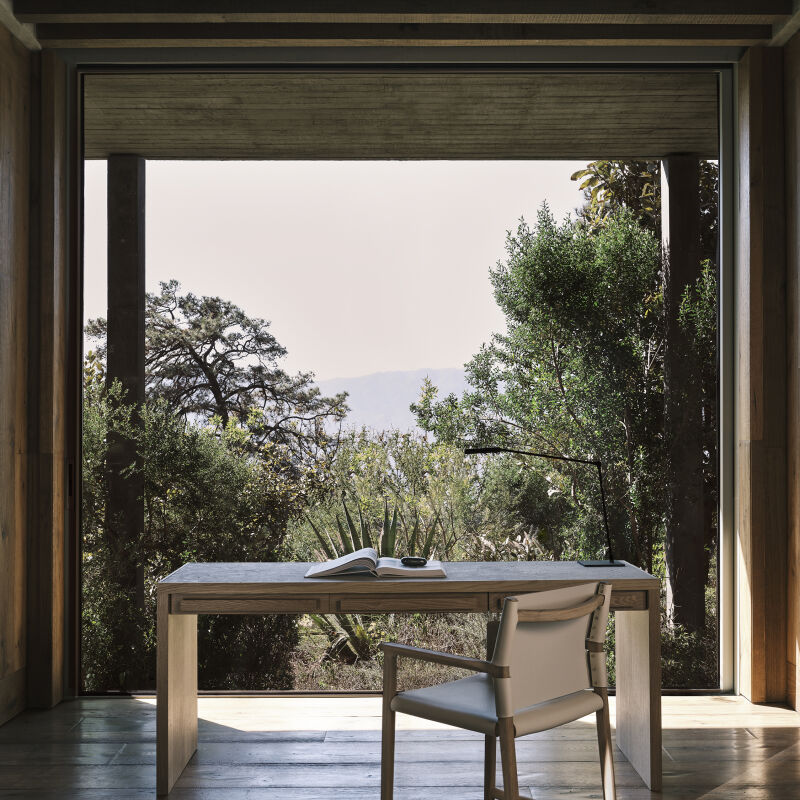Imagine cycling in the Flemish countryside and discovering an abandoned ruin of a once-grand house, 17th-century tower included. Most would probably muse about the possibilities, become frightened by the challenges, and then cycle away. Bram Seghers and Inge Buyse, however, are not most people. Founding partners of Buyse Seghers Architects, the couple bought the house to renovate and to live in with their two sons.
Known for their thoughtful design and sensitivity to light and proportion, the architects were careful to respect the architecture of the house, whose three-century span from the 17th to the 20th is visible in the layered marks of the exterior brickwork. “Even though the house had been continuously rebuilt, expanded, and altered, it was always thought of as one coherent structure, and we took the same approach,” Seghers says. “Our interventions do not have to be noticed; nor do we think that a strong contrast between the new and the old is always necessary.”
The architects created a modern, open feeling by bringing in more light through the house with new windows and additional interior openings. A multifunctional plan means that the house can function as one large home or two houses with separate entrances, providing ultimate flexibility for family living. “My parents currently occupy the second living unit, and my brother uses the upstairs studio when he joins us at Christmas and Easter. We open up the interconnecting, oversize doors, and it feels like one large, loftlike space, full of family and children.” A perfect fairy-tale ending.
Photography by Frederik Vercruysse via This Is Paper.

Above: The architects discovered the picturesque property while cycling in the Flemish countryside in Lovendegem, a town on the outskirts of Ghent. The property consists of the main house (pictured above), a few outer buildings, and an English garden.

Above: In the entry hall, the bluestone floor tiles are arranged in a classic Belgian pattern.

Above: From the dining room, there’s an uninterrupted view of the kitchen back to the entry wall, showing three different floor finishes, soaped solid oak, Rouge Belge marble, and bluestone tiles.

Above: In the kitchen the pale green of the cabinets complements the Rouge Belge marble countertops and floor. “We chose the wall colors to harmonize with the natural materials used in each room,” Seghers says. “Rooms that have marble floors have a soft gray on the walls.”

Above: “The red marble is Rouge Belge, chosen by the slab and selected for the combination of white veining that adds freshness,” Seghers says.

Above: The spare decor in the dining room with pale green walls is offset by the crystal chandelier, which was a family hand-me-down. “It came from Inge’s aunt,” Seghers says. “We know nothing about it, but thought it was a perfect match. The crystal pieces give off beautiful light.”

Above: The architects chose the white cotton fabric for the curtains for its ability to drape into soft but distinct folds.

Above: Large interior openings throughout the house provide glimpses of other rooms; the living room, seen here from the dining room, allows large amounts of natural light to flow through.

Above: A dark green classic French bistro teacup with saucer and milk jug set from Limoges sits on a stone fireplace mantel with a powdered white finish that has been handcut to the architects’ design.

Above: A view from the kitchen into the living room and dining room beyond. The large doors in the dining room open up to an adjacent office.

Above: In the office, the architects installed a small oval window, called an œil-de-bœuf, on the side of the house to allow more light in.

Above: Pale blue walls in the master bedroom complement the dark wood floorboards. “We always choose color on site, with painted wall samples in different tints,” Seghers says. “We test the colors against the exterior light conditions throughout the day.”

Above: A childhood desk lamp is repurposed into a bedside lamp.

Above: “Old floorboards that span the room were removed, restored, and reinstalled along with the original staircase,” Seghers says. “We stained them a dark color and scrubbed them with a beeswax finish.”

Above: Double doors lead to an expansive bathroom.

Above: The palette of the bathroom is off-white and neutral. The offset stacking pattern of the glazed porcelain tiles adds a simple but effective graphic note.

Above: Porcelain tiles line the walls of the shower.

Above: A portrait of the architects Bram Seghers and Inge Buyse as captured by photographer Frederik Vercruysse. The photos for this series were a result of a collaboration between the architects and Vercruysse titled “Portrait of House.” “Seeing Frederik’s personal work, ‘Table Composition,’ we were quite taken by the care and attention to detail and proportion he seems to share with ours,” Seghers says.

Above: In the back, the architects opened up the house to the garden and mirror pond by adding windows and carefully widening existing openings. The side elevations were opened up by adding porte-fenetres and an œil-de-bœuf placed into a rocaille stucco finish.

Above: A view through the back with the mirror pond frozen over. “The property itself is still in continuous evolution,” Seghers says. “We are working on a design for a new outer building that will house our offices, still renovating the garden, and continually buying and designing pieces that will add to the interior over time.”

Above: The entry level floor plan to Roode Port, the property’s official name, illustrates how the house can be used as one large unit or separated into two smaller ones.

Above: The master bedroom is located on the second floor.

Above: The third floor houses studios and additional family members.

Above: A cross section of the house.
Planning a cycling trip in Flanders and need somewhere to stay? See Glamorous Farm for Rent, Belgian Edition and A Bohemian B&B in Belgium. On Gardenista, we share 10 Garden Ideas to Steal from Belgium.
Frequently asked questions
What is the main material used in the Roode Poorte House?
The main material used in the Roode Poorte House is brick.
What was the inspiration for the design of the Roode Poorte House?
The design of the Roode Poorte House was inspired by the local traditional architecture of Flanders and the modernist architecture of Le Corbusier.
What are the key features of the Roode Poorte House?
The Roode Poorte House features an open plan living area, a large terrace, a swimming pool, and a garden designed by landscape architect Erik Dhont.
What is the location of the Roode Poorte House?
The Roode Poorte House is located in Ghent, Belgium.
Who designed the Roode Poorte House?
The Roode Poorte House was designed by Buyse Seghers Architects.
When was the Roode Poorte House completed?
The Roode Poorte House was completed in 2019.
Was sustainability taken into consideration during the construction of the Roode Poorte House?
Yes, sustainability was a key consideration during the construction of the Roode Poorte House, with features such as solar panels, underfloor heating, and a rainwater collection system.




Have a Question or Comment About This Post?
Join the conversation